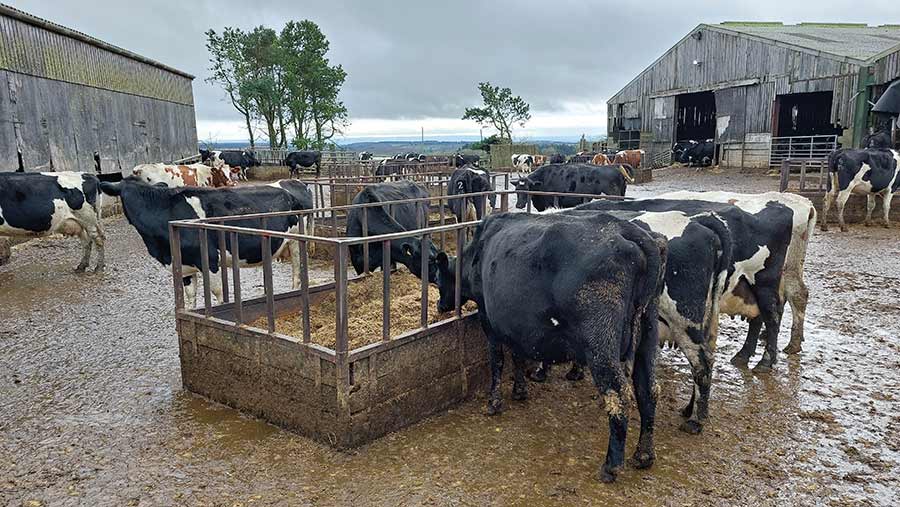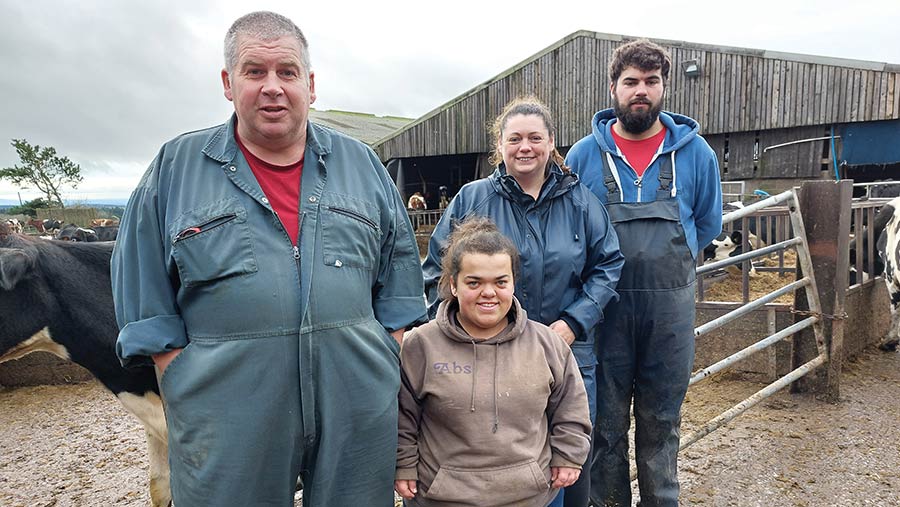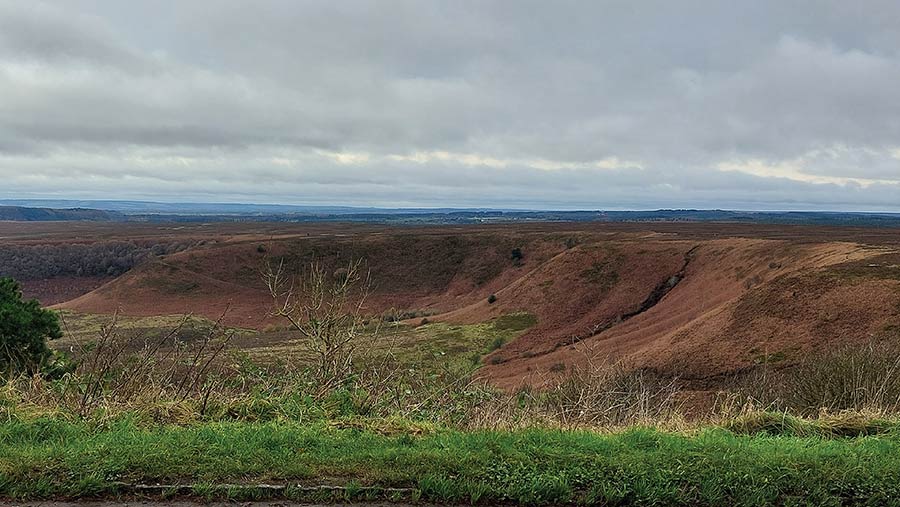How a 420-cow Yorkshire dairy manages at high altitude
 © MAG/Shirley Macmillan
© MAG/Shirley Macmillan Setting up a simple, grazing-based milk production system at 300m above sea level in North Yorkshire meant adapting to a cold spring and lower grass yields.
But good infrastructure allows Trevor Hodgson’s cows to go out as early as mid-March and stay out grazing until housing in November.
See also: Farmers Weekly Awards: Grassland Manager finalists 2020
His parents bought him Marfit Head Farm, at Saltergate, north of Pickering, as a beef and sheep unit in 1985, while his brother David stayed at the 120-cow home farm, 10 miles away.
Trevor began converting it to dairy in 1998: “I decided milk generated more revenue, which I needed as I had a young family,” he explains.
The sheep went, and home-bred heifers, together with the purchase of a 70-cow herd, set him up with 140 head. Trevor’s aim was to produce 6,500 litres on a low-input grazing system.
With no facilities for dairy cows – just some pens for beef cattle and lambing – he built 236 cubicles and a 20/40 parlour, plus a silage clamp and slurry pit.
Farm facts

Trevor, Abbie, Angela and Ben Hodgson © MAG/Shirley Macmillan
- Marfit Head Farm, Saltergate, Pickering, North Yorkshire
- 333m above sea level; light loam shallow soils over rock
- 875mm rainfall
- 109ha owned: 85ha grass, 24ha beans and cereals
- Rent 239ha next door since 2016
- Own 40ha farm 10 miles away for silage and heifers
- 400 ewes Swales and Dales-bred genetics tupped to Bluefaced Leicester and Teeswater
- 420 cross-bred dairy cows
- 6,500 litres at 4.6% fat and 3.5% protein
- 23 litres a cow a day from grazed grass in summer
- 240 replacement heifers
- Wethers fattened on autumn/winter grass; breeding gimmers sold
- 56-ewe pet lamb flock, all progeny fattened
- 50-60 free-range hens, 45-50 eggs/day sold on site
Over time, the herd grew and he employed a couple of staff.
When his brother exited dairying in 2010, Trevor took on all the cows and heifers, added another shed to provide a total of 426 cubicles, and extended the parlour to a 26/52 herringbone. Today he runs 420 cows plus 240 heifers.
To improve efficiency, he began cross-breeding with Jersey genetics, resulting in a lighter, hardier grazing cow with higher milk solids.
Cows are now a three-way cross of Norwegian Red, Jersey and Friesian bloodlines, weighing 550kg. He also saved up for a 58-point rotary in 2011 to reduce milking time to 1.5 hours.
Some 72,000 concrete railway sleepers were then laid to create a network of cow tracks for accessing grazing in wetter months.
“I’ve split fields into 15-20 acres [6-8ha]. We have more access [now] – we were having to cross a field to get to the next one – and can keep cows out longer without trashing fields,” he says.
Altitude challenges
Despite the low-cost approach, Trevor has not created a 12-week block-calving herd.
The farm lacks infrastructure and labour to cope, he says. Instead, the herd calves outside from May until the end of August/early September to match the later grass growth at this altitude.
“A turnout of February in the south is equivalent to May for us.
“Stale cows graze after the main mob, and between May and July we keep control of grass growth by strip grazing and back fencing. By the end of August, we rotate around night and day paddocks,” he explains.
“We are colder and not as early, so can’t grow as much grass because we get a late spring.
“Although, as long as we have no summer drought, we can benefit from autumn grazing.
“It’s a challenge in winter with ice in the parlour and frozen pipes. We might get a month of snow, and it blows off fields. But it is sound land and doesn’t flood.”
First-cut silage is in the last week of May, followed by second cut in mid-July, and a third in mid-September, which may be grazed if cows run short of grass.
The herd’s winter diet is kept simple and fed in troughs, with nothing in the parlour. Trevor layers pressed pulp, beans and oats in the grass clamp and also makes wholecrop wheat.
“We reseed two fields a year, about 60 acres [24ha], by putting in beans and oats; the second year is wheat for wholecrop, then grass,” he says.
“We are at the end of the line for electricity, which can cause problems, and we had to put two boreholes in because the mains didn’t have enough pressure or volume of water we needed.”
He adds that they have also invested in solar panels and a wood chip boiler to supply the farm’s energy needs.
Other income streams
Having swapped sheep and beef for dairy cows, Trevor has since reintroduced a flock of 400 ewes to make use of heather and bracken banksides on the farm rented next door, as well as tidy the dairy grazing platform.
He says he has no trouble finding dairy professionals visiting the region to help his business: he uses a consultant for projects, a foot trimmer, nutritionist and a parlour engineer.
But since the pandemic, a turnover of experienced and reliable staff has prevented the family from being able to take regular breaks or have time to develop ideas that add value to their farming business.
On top of that, farming in the North York Moors National Park means that some ideas – such as harnessing wind power or converting a barn into tourist facilities – are rejected at the planning stage.
This loses potential grant funding as well as opportunities to cut costs and improve revenue.
However, Trevor and his wife, Angela, have found ways to tap into the passing tourist trade.
They have operated a campsite since 1998 and are part-way through converting some barns into holiday cottages.
Their campsite has developed to include caravans, and a total of 50 pitches – with five shower blocks – now cater for 200 holidaymakers.
“We open at Easter, if the weather is suitable, or 1 May, and shut in mid-October,” says Angela, who takes all bookings.

© MAG/Shirley Macmillan
Future plans
The best bit about farming alongside the A169 between Pickering and Whitby is the view, says Trevor, and stunning scenery makes it a worthwhile day job.
He and Angela, their children Ben and Abbie (who work on the farm), and Thomas (a mechanic), are keen to capture more of the tourist potential their location brings them.
They would like a milk vending machine, a farm shop and time to host educational visits.
Being able to sell produce direct to the public would help negate the downturn in milk prices, says Trevor, who has only one milk buyer in the area.
He believes it is well worth showing children how milk is produced and teaching them about nature.
“We are still better off with a dairy herd – cows are the best-paying things. It’s just the lifestyle is hard with winter work and milking, and the past two years’ milk prices and rising costs have been difficult,” he says.
